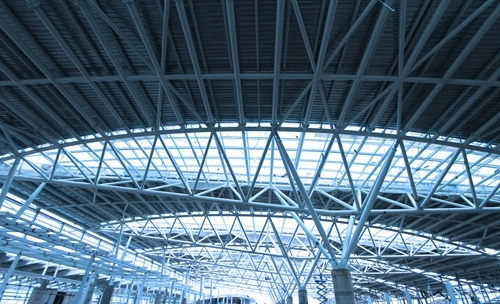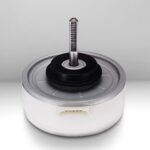Well, there is not much to explain here because the definition of steel structure is pretty simple. And what’s that? Simple: these are the structures that are made out of steel. That’s it. And if you want to know what exactly is steel, well, it is a super strong and reliable metal mix of iron and carbon. Usually, in these steel structures, you’ll see the main skeleton which is often made out of steel beams, columns, and some other parts.
And if you are wondering where exactly are these steel structures used, then you should know that heavy industrial buildings, high-rise buildings, any other infrastructure, bridges, metal or steel towers, airport terminals, pipe racks, and things like that (which you see all around you) are made possible because of these very steel structures. But it is not just the strength of the steel that makes these steel structures so favorite in the construction world, there is a lot more that needs to be discussed. We will certainly go over the benefits of using steel structures, but we aren’t biased, so we’ll also share what’s not so good about these steel structures. So, let’s get going.

Advantages of Steel Structures
1. High Strength-to-Weight Ratio
Probably one of the most important things you should know about steel structures is that they really have a great strength-to-weight ratio, and that’s the main reason why the construction world is practically in love with steel structures. And that’s because when you are building a structure with steel columns or beams or any other steel parts, you can keep the overall weight or load of the structure super low while still making it strong enough to literally withstand the test of time. In bridges and buildings, this is a big deal because steel can handle strong winds and earthquakes without any trouble. As a result? Strong and beautiful buildings that can carry heavy loads with less material.
2. Design Flexibility
Steel is very bendable, it is more like clay in the building or construction scene, to be honest. Do not take that as a literal thing, it is just to give perspective on things. Sure, steel is strong, so it can twist, bend, and stretch to fit even the wildest building ideas out there. This makes it a popular choice for modern designs that stand out and let in lots of air and light without having support beams in the way, right? All in all, making your strength look good is just as important as being strong.
3. Durability and Longevity For Sure
Steel is a strong material, unlike wood, which is beautiful but can be destroyed by bugs or rot. If you take care of it, it can last for hundreds of years, so it’s a good choice for the long term. Besides that, it doesn’t mind changes in temperature or humidity and stays cool when things get tough, you know?
4. Speed of Construction
Do you agree that time is money? Of course, it is! And that’s why we say that efficiency is the key to steel structures, though. Steel parts arrive ready to assemble after being prefabricated in quality-controlled settings. It’s like a big Lego set that snaps together quickly, which cuts down on the time it takes to build by a huge amount, that’s for sure.
5. Adaptability? Why Not!
Need to make changes to your building later on? Not a problem. It’s amazing how easy it is to adjust steel down the line. No matter, if you’re going up, out, or in, steel structures are easy to change. So, steel is a good choice for business areas that need to be flexible so they can grow and change with the company whenever the client wants.
6. Sustainability? Really? Yes!
Do you really care about the environment and know the impact of cement production on the environment? Well, in that case, you’ll love what steel structures have to offer. And what’s that? Well, steel can be recycled a lot, often up to 90% of its materials come from recovered sources, and can be melted down and used again when it’s done. Picking steel is good for the environment because it helps with sustainability one beam at a time.
Disadvantages of Steel Structures
1. Susceptibility to Corrosion
If you always thought that steel doesn’t corrode, well, you must recheck where you got that information from. Sure, steel CAN corrode, and it DOES. Untreated steel begins to rust in wet or salty conditions, which eventually reduces its overall strength. But it is really slow and doesn’t happen like normal iron. That’s how it is.
2. High Initial Cost
The price of steel up front can hurt your wallet for sure. Prices are higher than for materials like wood or concrete because it takes a lot of energy to make and skilled workers to put together. The cost can be a problem at first, but it will pay off in the long run with fewer fixes and replacements.
3. Fire Protection Requirements
See, high temperatures can make steel soft, which can cause a structure to break down. To keep things cool, fire-resistant material needs to be put on top of steel frames. Without a doubt, this can add to the cost and make the build more difficult.
4. Thermal Conductivity
This is a hot (and cold) topic: steel moves or conducts heat around very well, which may not be a good thing when you’re adding up your energy costs. Places that are cold lose heat quickly, while places that are warmer can turn houses into ovens. How to fix it? It takes more materials, work, and money to add layers of insulation.
5. Complexity in Connections
Putting together steel pieces isn’t easy. It takes more time and money to find the right crew because it needs more skill and accuracy, like when you’re welding or bolting. Any mistakes made here could cause a lot of trouble later on and could even damage the building itself.
Comparison Table for Advantages and Disadvantages of Steel Structures
| Advantages | Disadvantages |
| High Strength-to-Weight Ratio | Prone to Corrosion |
| Flexible Design Capabilities | Expensive Initial Cost |
| Long-lasting and Durable | Requires Fire Protection |
| Quick Construction Process | High Thermal Conductivity |
| Easily Adaptable | Complex Connections |
| Environmentally Sustainable |

